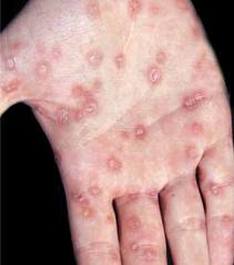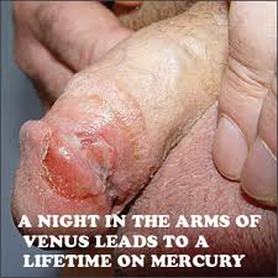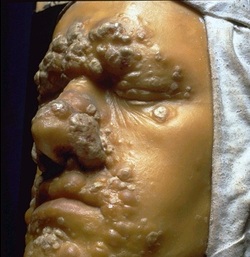Columbus and Syphilis

Christopher Columbus - syphilitic seafairer
Syphilis was thought to have been a Greek shepherd. But any notions of affection between him and his sheep as a cause for the disease should be tempered with a tidbit of medical historical knowledge – Christopher Columbus may be the one to blame for modern day syphilis!
Sailors and syphilis are almost synonymous. One of my medical school profs was in the Navy during WWII and learned from his colleagues to “ beware of the tattooed man”! Men with tattoos invariably were sailors, and sailors invariably had syphilis!
Sailors and syphilis are almost synonymous. One of my medical school profs was in the Navy during WWII and learned from his colleagues to “ beware of the tattooed man”! Men with tattoos invariably were sailors, and sailors invariably had syphilis!
Handy things to know

Syphilis on a hand
This same professor also once flunked a medical student for shaking hands with a patient with a funny rash on his palms. The profs’ parting shot was to inform the student that not only had he flunked the exam, but he had better go wash his hands. He had just shaken a syphilitic hand (and was perhaps in danger of coming down with the one handed clap!).
Syphilis becomes an international disease of mystery...

Socializing with new world natives
But back to Columbus. Syphilis first appeared in Europe in a massive outbreak in the early 1500’s. In fact, it may have had more of the effect on European history than any other disease, with the exception of the Black Death.
One theory is that the disease was contracted in Haiti by members of Columbus’ crew, who later joined the army of Charles VIII of France, and participated in the siege of Naples. The town surrendered on 22 February 1495 at 4 p.m., and the orgies which followed were the birthplace of the great European syphilis pandemic.
There was a time when one in ten people in Europe suffered from the disease. (Early in this century one in nineteen Americans had the condition.) These included the rich and famous. Catharine the Great of Russia established centers for the treatment of syphilis. Historical records hint that she may have had a personal interest in doing so -- she may have had the disease herself. Incidentally, Russians called it the Polish sickness. Poles named it the German sickness. The Germans, Italians, and English all referred to it as the French disease.
One theory is that the disease was contracted in Haiti by members of Columbus’ crew, who later joined the army of Charles VIII of France, and participated in the siege of Naples. The town surrendered on 22 February 1495 at 4 p.m., and the orgies which followed were the birthplace of the great European syphilis pandemic.
There was a time when one in ten people in Europe suffered from the disease. (Early in this century one in nineteen Americans had the condition.) These included the rich and famous. Catharine the Great of Russia established centers for the treatment of syphilis. Historical records hint that she may have had a personal interest in doing so -- she may have had the disease herself. Incidentally, Russians called it the Polish sickness. Poles named it the German sickness. The Germans, Italians, and English all referred to it as the French disease.
Venus and Mercury

Syphilis on a penis
The treatment of syphilis was initially by injections of mercury into the affected areas. Since Venus was the god of love and Mercury was the messenger of the gods, many an unfortunate sailor was warned about the dangers of spending “one night with Venus and the rest of your life with Mercury”.
Mercury injections were used for centuries, but were never very successful. A greatly improved treatment was developed at the Mayo Clinic – injections of arsenic! Another popular treatment invoked deliberately giving syphilitics malaria. There was a belief that catching malaria could relieve some of the symptoms of syphilis.
Eventually modern antibiotics led to a more casual attitude about getting a dose of the clap. Sailors on battleships frequently had to muster for "short arm" inspection. The constant worry (in the days prior to routine childhood vaccinations) was that they might develop mumps of the testicle -- a very painful condition that often led to permanent infertility. Many a sailor was heard too exclaim "thank God I’ve only got syphilis -- for a moment there I thought it might be the mumps!"
The symptoms of syphilis are as varied and interesting as its history. It has been described as "the great imitator", because of the great diversity and variety of symptoms. It can cause everything from a painless sore on the genitals to arthritis to a type of chronic insanity that has been occasionally misdiagnosed as schizophrenia.
Mercury injections were used for centuries, but were never very successful. A greatly improved treatment was developed at the Mayo Clinic – injections of arsenic! Another popular treatment invoked deliberately giving syphilitics malaria. There was a belief that catching malaria could relieve some of the symptoms of syphilis.
Eventually modern antibiotics led to a more casual attitude about getting a dose of the clap. Sailors on battleships frequently had to muster for "short arm" inspection. The constant worry (in the days prior to routine childhood vaccinations) was that they might develop mumps of the testicle -- a very painful condition that often led to permanent infertility. Many a sailor was heard too exclaim "thank God I’ve only got syphilis -- for a moment there I thought it might be the mumps!"
The symptoms of syphilis are as varied and interesting as its history. It has been described as "the great imitator", because of the great diversity and variety of symptoms. It can cause everything from a painless sore on the genitals to arthritis to a type of chronic insanity that has been occasionally misdiagnosed as schizophrenia.
The Tuskeegee Syphilis Experiment

Syphilis courtesy of the US government
In an attempt to observe the course of untreated syphilis many African Americans were involved in an involuntary experiment.
The Tuskegee Study followed 400 Black sharecroppers from 1932 to 1972. This study became the longest non-therapeutic experiment on humans in the history of medicine, and an example of gross exploitation.
The men were never told they had syphilis. They were told they had "bad blood" and were denied access to treatment, even for years after penicillin came into use in 1947.
By the time the study was exposed in 1972, 28 man had died of syphilis, 100 others were dead of related complications, 41 wives had become infected, and 19 children had been born with the disease.
The Tuskegee Study followed 400 Black sharecroppers from 1932 to 1972. This study became the longest non-therapeutic experiment on humans in the history of medicine, and an example of gross exploitation.
The men were never told they had syphilis. They were told they had "bad blood" and were denied access to treatment, even for years after penicillin came into use in 1947.
By the time the study was exposed in 1972, 28 man had died of syphilis, 100 others were dead of related complications, 41 wives had become infected, and 19 children had been born with the disease.
Syphilis lessons for today

Syphilis on a face !
Syphilis has important lessons to teach us today. It is an example of how human behavior and disease can interact. It has some of the same social connotations that HIV has today. Many people are interested in finding a cure, but many others think of it as a “scourge from God” that is just giving sinners what they really deserve.
If we handle HIV as badly as we did its predecessor then we may be in significant trouble. For example, despite very effective antibiotic treatment, syphilis is making a comeback. There are currently over a hundred cases in British Columbia. (Be careful who you shake hands with!)
Perhaps the writers of the magazine “Scientific American” expressed it most poignantly:
"Inextricably woven into the very fabric of human behavior, syphilis could not remain a topic for physicians alone. This humane and gently ironic historian places before us, period by period, the changing responses of morality and medicine, of writers and dramatists, and of state power itself."
If we handle HIV as badly as we did its predecessor then we may be in significant trouble. For example, despite very effective antibiotic treatment, syphilis is making a comeback. There are currently over a hundred cases in British Columbia. (Be careful who you shake hands with!)
Perhaps the writers of the magazine “Scientific American” expressed it most poignantly:
"Inextricably woven into the very fabric of human behavior, syphilis could not remain a topic for physicians alone. This humane and gently ironic historian places before us, period by period, the changing responses of morality and medicine, of writers and dramatists, and of state power itself."